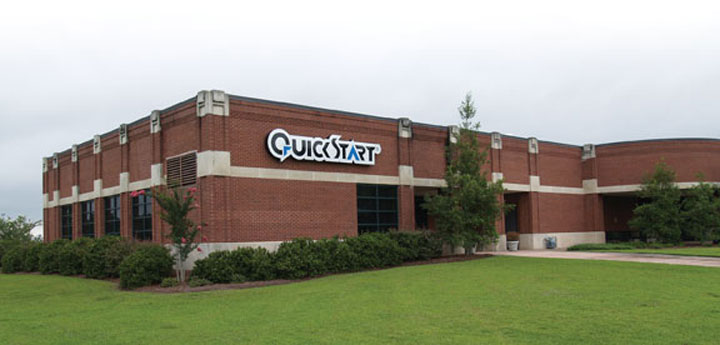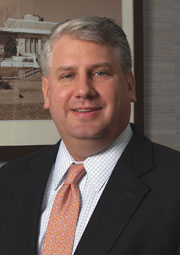
hat’s a school to do when an area’s demand for a university presence is growing at the same robust rate as the area’s companies, but funds for facility development already are spread thin?
Look to Savannah, Ga., for one solution. That’s where The University Financing Foundation, Inc. (TUFF), a 501(c)(3) tax-exempt organization based in Atlanta, worked with International Paper, Savannah Technical College, the Georgia Institute of Technology and the Savannah Economic Development Authority to bring new economic development capacity to southeast coastal Georgia four years ago. Today, there are three buildings, with one more coming on board, to serve the training needs of expanding operations at Gulfstream Aerospace – located some 100 yards (91 m.) away.
In 2003, TUFF purchased a vacant 40,000-sq.-ft. (3,716 sq.-m.) building from International Paper for US$4 million, renovated it and leased it back to the State of Georgia for use by Savannah Technical College.
“We took what was financed by International Paper – taxable debt, they were using their own equity, with a cost of capital of 6 percent to 15 percent,” says Kevin Byrne, chief investment officer for TUFF. “Because we’re 501(c)(3), we can borrow at tax-exempt rates, so for this Savannah Tech facility, we borrowed 100 percent of the cost of acquisition at an approximate interest rate of 3.5 percent. If International Paper had wanted to hold on to the property and lease it to Savannah Tech, the lease rates would be double what they would be if TUFF were involved – our cost of capital is half to 65 percent of their cost of capital. It’s just a different delivery method for any institution across the country to acquire high-performance, corporate used facilities.”
Gulfstream is in the midst of multiple facility expansions of its own, right in the same Crossroads Industrial Park.
“A technical college’s job is to provide the right type of people for these expanding companies,” says Byrne. “So now we’re in the process of building a second building, mainly for aircraft training, for Savannah Tech to provide people to Gulfstream to build these airplanes.”


Over the same time frame, momentum was building in the Savannah area for an engineering school. When state officials were petitioned to set one up, Georgia Insitute of Technology had something to say about it: Why not start a new Georgia Tech campus?
Again, TUFF was involved, extending a working relationship with Georgia Tech that goes back to the firm’s inception in 1982. The three-building Technology and Engineering campus in Savannah houses the Georgia Tech Regional Engineering Program (GTREP) program along with the Savannah offices of the Yamacraw broadband technology research program and a branch of Georgia Tech’s Advanced Technology Development Center.
Tech used state appropriations to buy back one of the buildings, encompassing 18,000 sq. ft. (1,672 sq. m.). TUFF owns the other two facilities encompassing 100,000 sq. ft. (9,290 sq. m.), leases them to the school’s Board of Regents and manages the property. TUFF provided interim short-term equity and $18.6 million in tax-exempt bonds issued by the Savannah Economic Development Authority (SEDA), and a $4-million commercial loan. TUFF will convey the property to the tenant at the end of the lease term. And all of the activity is taking place on land conveyed to the state by SEDA.
Byrne says universities and colleges are faced with three alternatives. The first is the pure profit model, where a third party develops, builds or buys an asset and leases it back to the college. Second, the school can do it by itself. Byrne says TUFF offers a hybrid model that can be good for both the educational institution and for corporate end users looking to dispose of assets. He cites two buildings being looked at for purchase in California, currently owned by big corporate users who don’t want to move out immediately, but want to reduce their space.
“The concept is to buy the building now, let the leases burn off over five to eight years, and as they burn off in some graduated way, the institution gradually takes over the building,” he says. “It’s a different financing model, because I can’t use tax-exempt for those years, but a blended model is based on the number of days the corporate user is using the facility. I can charge a rent to the taxable end user that is higher, so the tax-exempt user doesn’t have to carry any of the burden of the higher taxable debt.”
Asked if he’s seeing much interest from big pharma as it seeks to hive off R&D space, Byrne says yes. It’s why the firm is working with Georgia Tech on another research park project in Atlanta, to incubate and accelerate early-stage medical device and drug companies, most of which are looking to be bought.
Byrne points out that the pending lease accounting changes that have grabbed the attention of private industry corporate real estate directors are of equal interest to their counterparts in the university world. He says getting projects off the balance sheet is one thing, but off credit is another, more challenging aspect.
“It’s more difficult to define, and especially now with the complications on subprime lending, if they smell essentiality to the school, they will try to attribute it to the credit of the institution,” he says. “The consequence of off credit is it’s a lease that impacts the school’s ability to borrow money. Schools now want to minimize their capital leases, because they need the credit to go out and build student housing. If it can be off credit, schools can have more capacity to borrow for the next big science or classroom building.”
Byrne’s firm is trying to “get people to begin their process now, to get grandfathered in” before the lease accounting changes occur in two to three years.
Byrne says the firm has done the majority of its $700 million of financing in just the past few years.
“People really want to expand their campuses,” he says. “We’re becoming the resource for them to do it.”
Site Selection Online – The magazine of Corporate Real Estate Strategy and Area Economic Development.
©2008 Conway Data, Inc. All rights reserved. SiteNet data is from many sources and not warranted to be accurate or current.